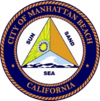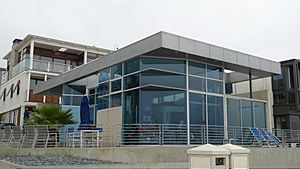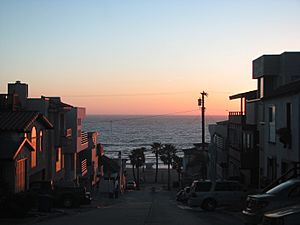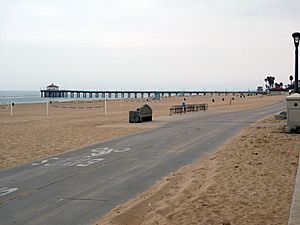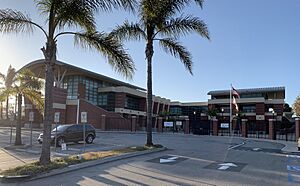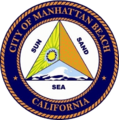Manhattan Beach, California facts for kids
Quick facts for kids
Manhattan Beach, California
|
|||
|---|---|---|---|
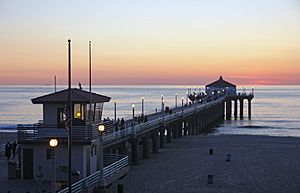
The Manhattan Beach Pier on a typical fall afternoon
|
|||
|
|||
| Motto(s):
"Sun, Sand, Sea"
|
|||
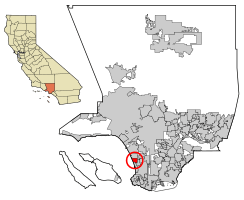
Location of Manhattan Beach in Los Angeles County, California
|
|||
| Country | United States | ||
| State | California | ||
| County | Los Angeles | ||
| Incorporated | December 12, 1912 | ||
| Named for | Manhattan | ||
| Government | |||
| • Type | Council-Manager | ||
| Area | |||
| • Total | 3.94 sq mi (10.20 km2) | ||
| • Land | 3.93 sq mi (10.19 km2) | ||
| • Water | 0.00 sq mi (0.01 km2) 0.1% | ||
| Elevation | 66 ft (20 m) | ||
| Population
(2020)
|
|||
| • Total | 35,506 | ||
| • Estimate
(2022)
|
34,137 | ||
| • Density | 9,025.4/sq mi (3,484.7/km2) | ||
| Time zone | UTC-8 (Pacific) | ||
| • Summer (DST) | UTC-7 (PDT) | ||
| ZIP codes |
90266, 90267
|
||
| Area codes | 310/424 | ||
| FIPS code | 06-45400 | ||
| GNIS feature IDs | 1660985, 2411020 | ||
Manhattan Beach is a sunny city in Los Angeles County, California, right on the Pacific Ocean. It's located south of El Segundo and north of Hermosa Beach.
In 2020, about 35,506 people lived here. Manhattan Beach is one of the three "Beach Cities" in the South Bay area. The others are Hermosa Beach and Redondo Beach.
The city is famous for its long beach, which stretches about 2.1 miles (3.4 km) and is about 450 feet (137 meters) wide. The weather is usually mild because it's so close to the ocean. The average high temperature is around 69.1°F (20.6°C) all year.
Contents
History of Manhattan Beach
In 1863, a man from Scotland named Sir Robert Burnett bought a large area of land. This land included what is now Manhattan Beach. Ten years later, in 1873, Burnett rented the land to Daniel Freeman, a Canadian.
Freeman moved his family to the ranch and started growing crops. In 1885, Freeman bought the ranch from Burnett.
Later, a lot of the land in northern Manhattan Beach was owned by George H. Peck. The name of the town was decided by a coin flip! Around 1902, the beach town was named "Manhattan." This was after developer Stewart Merrill's home in New York City. The word "Beach" was added to the city's name in 1927.
The area where Manhattan Beach now stands used to be covered in sand dunes. In the 1920s and 1930s, builders flattened these dunes. Some of the extra sand was even sent to Waikiki, Hawaii. It helped turn their rocky beach into a sandy one. This sand was also used to build the Los Angeles Coliseum.
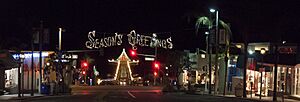
Geography and Climate
Manhattan Beach enjoys cool ocean breezes. These breezes keep the air clean and summer temperatures much cooler than inland areas. The city is about 3.9 square miles (10.2 square kilometers) in total area. It has 2.1 miles (3.4 km) of oceanfront.
Many famous people from sports and entertainment live here. They like the ocean views, great schools, and easy travel to Los Angeles. GQ Magazine even called Manhattan Beach one of the nation's six best beaches in 2014.
Beach and Sand Dunes
Manhattan Beach is a popular spot for beach volleyball and surfing. Most of the city is built on what used to be sand dunes. These dunes give many homes great ocean views. The tallest hill is 244 feet (74 meters) high.
The only remaining sand dune you can see is at Sand Dune Park. In the 1920s, extra sand from Manhattan Beach was bought by developers in Hawaii. They shipped it across the Pacific Ocean to Waikiki Beach.
The beach is about 400 feet (122 meters) wide and 2.1 miles (3.4 km) long. It used to be much narrower. It became wider from 1938 to 1989. This happened when a lot of sand was added to beaches north of the city.
Every August, Manhattan Beach hosts the Manhattan Beach Open Volleyball Tournament. It also holds the International Surf Festival.
Neighborhoods to Explore
Manhattan Beach has several unique neighborhoods. These include the "Sand Section," "Hill Section," and "Tree Section." There's also "The Village," "Manhattan Heights," and "El Porto."
The "Hill Section" is known for its expensive homes. Many of these homes have been updated or are newly built. The steep hills offer amazing views of the ocean and the city.
The "Sand Section" is famous for its quiet streets near the ocean. Homes along "The Strand" are right on the beach. This area has some of the most expensive real estate in the United States.
Since 2010, new buildings in Manhattan Beach can't be too big. This rule helps keep the beach community looking nice.
Downtown Manhattan Beach
"Downtown" Manhattan Beach is the lively center of the city. It's located around Manhattan Beach Boulevard and near the Manhattan Beach Pier. You'll find many great restaurants and unique shops here. It's a fun place to walk around.
The Metlox site, where a pottery factory once stood, is now a modern center. It has a fancy hotel, a spa, restaurants, and shops.
North Manhattan Beach District
The North Manhattan Beach business district is near Rosecrans and Highland. It has many excellent restaurants and shops. This area covers "32nd Street to 45th Street" and has over 80 businesses.
Rosecrans Corridor
The "Rosecrans corridor" is a commercial area. It's home to the Manhattan Beach Country Club and the Marriott Hotel. You can also find retail stores, restaurants, and office buildings here.
Sepulveda Corridor
The "Sepulveda Corridor" is another commercial area. It's along the city's main north-south highway. Here you'll find the Manhattan Village Mall. The mall has stores like Macy's, Pottery Barn, and the Apple Store. There are also many restaurants and car dealerships along this road.
Aviation Corridor
The "Aviation Corridor" is on the eastern edge of the city. It has major entertainment and aerospace companies. Manhattan Beach Studios is located here. Many popular movies, like Marvel's "Thor" and "Iron Man 2," were filmed at this studio. The studio also has a huge solar panel system on its roof.
Population Facts
| Historical population | |||
|---|---|---|---|
| Census | Pop. | %± | |
| 1920 | 859 | — | |
| 1930 | 1,891 | 120.1% | |
| 1940 | 6,398 | 238.3% | |
| 1950 | 17,330 | 170.9% | |
| 1960 | 33,934 | 95.8% | |
| 1970 | 35,352 | 4.2% | |
| 1980 | 31,542 | −10.8% | |
| 1990 | 32,063 | 1.7% | |
| 2000 | 33,852 | 5.6% | |
| 2010 | 35,135 | 3.8% | |
| 2020 | 35,506 | 1.1% | |
| U.S. Decennial Census | |||
In 2010, Manhattan Beach had a population of 35,135 people. Most residents lived in homes, not group housing. About 33.7% of households had children under 18.
The median age in the city was 40.9 years. Many people who work in sports and entertainment live in Manhattan Beach. This is because of its beautiful oceanfront and excellent schools.
Economy and Jobs
Manhattan Beach has a strong economy. Here are some of the top employers in the city:
| # | Employer | # of Employees |
|---|---|---|
| 1 | Target | 405 |
| 2 | Skechers | 362 |
| 3 | Macy's | 271 |
| 4 | Fry's Electronics | 251 |
| 5 | Marriott | 208 |
| 6 | Ralphs | 146 |
| 7 | Olive Garden | 143 |
| 8 | 24 Hour Fitness | 133 |
| 9 | Bristol Farms | 130 |
| 10 | Shade Hotel | 113 |
| 11 | Manhattan Beach Toyota | 99 |
| 12 | Houston's Restaurants | 97 |
| 13 | California Pizza Kitchen | 85 |
| 14 | Chili's | 81 |
| 15 | Belamar Hotel | 79 |
| 16 | Islands | 75 |
| 17 | REI | 62 |
Homes in Manhattan Beach are very expensive. In 2013, more homes over $1 million were sold here than in any other California city. The "Hill Section" of Manhattan Beach has one of the highest average household incomes in Los Angeles County.
Parks and Recreation
The wide, sandy beaches attract over 3.8 million visitors each year. Beach volleyball, swimming, body boarding, and surfing are popular activities. Good surf spots include the pier and El Porto.
Lifeguards are stationed along the beach. The beach is cleaned daily by the LA County Beaches and Harbors Department. Along the beach, there's a concrete bike path for bicycles. This path goes north to Santa Monica and south to Torrance. A separate walking path runs next to the bike path.
Veteran's Parkway is a popular walking trail. It's about 3 miles (4.8 km) long and is great for runners and dog-walkers.
Polliwog Park is the largest and most popular park. It has the Manhattan Beach Botanical Garden, a small lake, and an outdoor concert area. There are also playgrounds, picnic tables, and a fenced dog park. The Manhattan Beach Historical Society Red Cottage is also located here.
Marine Avenue Park has lighted ball fields, basketball courts, and an indoor racketball facility. A small skate park was added to Marine Avenue Park in 2017. Live Oak Park in downtown has ball fields, batting cages, and tennis courts. Begg Pool offers swimming programs all year.
Every August, the city hosts an annual Hometown Fair at Live Oak Park. This fair has food, live music, games, and booths that raise money for local causes.
Education in Manhattan Beach
Manhattan Beach is known for its highly educated residents. It ranks as the second most educated city in Los Angeles County. It's also the fifth most educated city in California.
Schools in the City
| School | 2010 API Score |
|---|---|
| Grandview Elementary | 957 |
| Meadows Elementary | 946 |
| Pacific Elementary | 960 |
| Pennekamp Elementary | 948 |
| Robinson Elementary | 962 |
| Manhattan Beach Middle | 945 |
| Mira Costa High School | 911 |
Public schools in Manhattan Beach are part of the Manhattan Beach Unified School District (MBUSD). This district includes five elementary schools: Grand View, Meadows, Pacific, Pennekamp, and Robinson. There is one middle school, Manhattan Beach Middle School. The high school is Mira Costa High School.
The MBUSD is ranked as one of the best school districts in California. It received a high score on the California Academic Performance Index in 2010. Forbes Magazine even ranked MBUSD as the sixth best school district in the United States.
Private schools in Manhattan Beach include American Martyrs Catholic School and Montessori School of Manhattan Beach.
Local Media
Manhattan Beach has several local newspapers. These include Easy Reader-Manhattan Beach and Beach Magazine. Residents also read the Daily Breeze and the Beach Reporter.
Public Transportation
Manhattan Beach is served by Beach Cities Transit. The Douglas and Redondo Beach C Line train stations are nearby. In the past, Manhattan Beach was served by the Pacific Electric streetcar system.
Images for kids
-
The Manhattan Beach Pier on a typical fall afternoon
-
Location of Manhattan Beach in Los Angeles County, California
See also
List of people from Manhattan Beach, California  In Spanish: Manhattan Beach (California) para niños
In Spanish: Manhattan Beach (California) para niños



